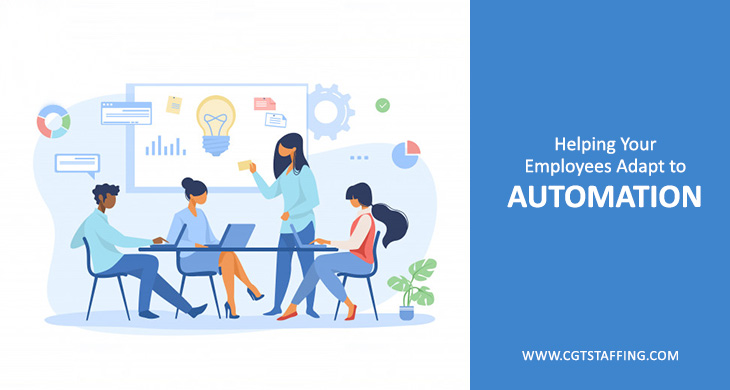Automation is one of the defining characteristics of the 21st Century. Unfortunately (and understandably), many American workers remain wary of automation in the workplace. Many fear that it inevitably makes them obsolete, threatening their usefulness and marketability. Others view it disparagingly as a tool for management to cut costs.
Automation affects a significant chunk of the American workforce. Amid all these challenges, how do you help your employees accept and adapt to automation? This blog explores that pressing question.
Table of Contents
How to Help Employees Adapt to Automation?
Prior to examining the ways you can help your employees adapt to automation, it’s first necessary to properly define the term. “Automation” involves the utilization of a mix of hardware and software to create automatic parts or processes within different business functions. The most obvious example is the use of robotic workers in an automobile assembly line. This automation has helped the auto industry cut costs, increase production quantity, and improve production quality.
You May Like: Improve Hiring by Creating Candidate Personas
One thing about which to be clear from the outset: automation can and does make certain jobs obsolete. At the same time, however, it also creates opportunities for new jobs. In any case, the impact of automation has been felt across a diverse range of industries and business functions for some time now. Here are four ways you can make the process of adapting to it easier for your employees:
- Alleviate Concerns Transparently
- Be Specific about the Impact
- Engage With Employees on a Personal Level
- Help Them Reinvent Skills
Let’s examine these in more detail below.
Alleviate Concerns Transparently
Transparency is an important part of running an ethical business, regardless of industry. You have a responsibility to your employees to be transparent about new changes and the necessary implications of change. This is especially true in cases of any high-impact evolution, of which automation is a part.
Your employees are bound to have serious concerns over new automation. Many workers live in fear of machines making their jobs obsolete. However, being transparent from the outset about your move toward automation can help alleviate their concerns. This works best if transparency is a characteristic of every level of the business hierarchy. Explain to your team the benefits that automation will bring to the business.
At the same time, be sure to communicate individually with any stakeholder whose job will be affected, whether positively or negatively.
Be Specific about the Impact
Being specific about the impact of automation goes hand-in-hand with being transparent about it. Promoting transparency and honesty is part of your duty as a business manager. By evading any specific questions, you give rise to a trust deficit between workers and management.
You May Like: Hiring Mistakes: The Cost of a Bad Hire
In outlining the impacts of automation, strive to be specific about the short-term as well as the long-term business impacts. Paint a clear picture in order to justify the decision to automate. This includes being specific about the jobs the automation will impact the most.
Engage With Employees on a Personal Level
It is not enough simply to be transparent and specific in your communications. You also need to engage with employees on a personal, one-on-one basis; specifically, the employees most affected by automation.
On the whole, your workforce is due an honest explanation of the effects of a change to any business process. This might constitute increased responsibility, decreased workload, a growth opportunity, or even elimination as a result of the changes. Spend time on how you intend to help employees struggling to adapt to change.
Help Them Reinvent Skills
Any change to processes, whether positive or negative, will likely require employees to alter their current skill sets. A formal program within your organization to help with workforce adaptation can help ease this adjustment. It will offer a means to shift workers around in a cost-effective manner and track their performance at the same time.
After all, even with automation, businesses operate best when machines and humans work together in tandem. Maximize this by offering your workers the opportunity to add new skills.
Frequently Asked Questions
How do you prepare your employees for automation?
By being transparent, specific, personal, and offering skill enrichment.
How do you automate HR processes?
HR processes like payroll management and candidate tracking can be automated using different software.
What is workforce automation?
It is defined by the use of machines and computers to work automatically and without human input.
What are the types of automation?
Fixed, programmable, and flexible.
What is the purpose of automation?
To help businesses operate more efficiently and incur lower costs.
What are the advantages of automation?
Less dependence on humans, fewer errors, fewer delays and consistent quality.
